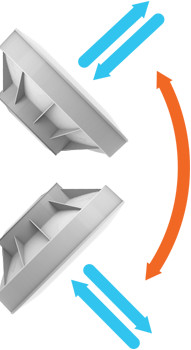The B5c Backhaul is changing the game. Leveraging 802.11ac, 4x4:4 MIMO and radical engineering for service providers that demand the same capacity, speed and reliability as fiber. With 1.7 Gbps PHY and a unique spin on reliability, the B5c is re-defining gigabit wireless technology.
The B5c is capable of 1 Gbps throughput. The B5c can be paired with any dual-polarized antenna and is operational from 4900-6000 MHz.
The B5c brings with it an entirely new set of features never seen before in the outdoor wireless market.
Read our TDMA and Collocation Synchronization whitepaper to learn more about using the B5c in your network.
Dual Link
Dual Link revolutionizes backhaul reliability by load balancing across two non-contiguous channels to avoid outages due to interference. If one channel experiences interference the radio maintains connection while simultaneously searching for new replacement channel.
Additionally, Dual Link adds value by easing difficulties when searching for available spectrum in congested areas. Now, bandwidth can be split across two different channels. Experience the same throughput, with less complication.
TDMA-FD
For the highest interference environments, the new TDMA-FD (Frequency Diversity) feature allows each radio to operate on a separate preferred RX channel that is optimal for local interference. After the RX window has completed, the radio then flips channels to TX on the preferred channel of the remote side radio. This mode can be enabled for 1 x 20/40/80 MHz modes, for IP throughputs up to 750 Mbps.
Auto Everything
Wireless interference can change in an instant, and your network needs to adapt. The Mimosa B5 offers constant spectrum analysis with historical and real-time data to dynamically make smarter decisions.
The Auto Everything feature will automatically adjust frequency, channel width and power levels based on environmental feedback. This feature can be turned off for users that prefer more control.

Local and Network-Wide Spectrum Recycling
With scarce spectrum and lots of traffic to transmit, collocation of devices is a must. While this has been a constant struggle for most of the products on the market, the B5 takes an advanced approach. Using standard GPS and GLONASS for sync, we can ensure that all radios on the network are transmitting and receiving at the same time to avoid any interference. For even more protection, we use the most advanced RF isolation on the market, allowing radios to operate in close proximity to one another.
Learn more: TDMA and Collocation Synchronization Whitepaper
Backhaul Made Simple
Low Power.

To save you operating costs, we engineered the perfect solution for solar-based deployment: 1 Gbps performance with GPS sync delivered in under 20W.
Reliable

Outdoor IP67 rating, extended temperature operation and fully-integrated lightning ESD protection make the B5 ultra-tough.
Easy

A dedicated 2.4 GHz Wi-Fi management radio lets your smartphone easily configure the B5 from the bottom of the tower. Smart GPS-assisted aiming technology triangulates your link's goal signal strength for fine tuning.
High Performance
The Mimosa TDMA protocol establishes a new benchmark for PHY:MAC efficiency and spectrum re-use.

Each Mimosa backhaul radio includes an integrated high sensitivity GPS + GLONASS receiver for the best possible satellite reception, and consistent high-precision 1 PPS-based timing for coordinating TX/RX sync.

Configure the radio for an equal (50%/50%) or unequal (75%/25%) traffic splits to maximize throughput in the downlink direction.
Advanced RF Efficiencies
Stream Power Peaking- Multi-stream MIMO radios normally settle on the lowest MCS rate across all the streams, severely degrading performance. Mimosa’s backhaul radios constantly advise the remote-side radio of individual stream receive levels, increasing those signal levels to meet the highest common attainable MCS rate.
Predictive AGC- When there’s a consistent signal from a single client, Mimosa’s Automatic Gain Control narrows the gain window of the receive signal amplitude for the next incoming packets (by 8 dB) to accelerate packet signal level detection.
Precision Receive Activation- A technique by which the receiver is precision-activated only when packets are expected to arrive over the link. Thus reducing the potential interference typically seen if a receiver prematurely begins decoding.